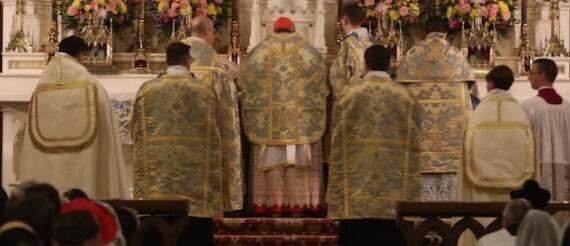Really, the better title of this blog should be “The Roman Canon is the Oldest Eucharistic Prayer and those of the Eastern Liturgies.” What is excluded from this? Obviously, the Novus Ordo‘s Eucharistic Prayer II, III and IV are all very new man-made prayers. They are not of Apostolic Origin. But for some reason, that isn’t so “obvious” to most Catholic educators today.
One of the strangest modern-myths pushed in my mainstream-seminary years ago (and probably still today) was that “Eucharistic Prayer II is older than Eucharistic Prayer I.” (That sounds as silly as saying, “The New Mass is older than the Old Mass.”) As most of you know, what modernists call “Eucharistic Prayer I” is actually the Roman Canon. The Roman Canon is used exclusively even to this day in the Traditional Latin Mass (TLM) as the only backbone Eucharistic Prayer following the Sanctus.
However, in the Novus Ordo Mass (NOM) I would say (especially after having con-celebrated the NOM on several continents before I switched to tradition) that 98% of NOM priests around the globe choose Eucharistic Prayer II or II or IV for their daily Mass. (Eucharistic Prayer II is the fastest…extremely short, in fact.) How old is the theology to these Masses?
In seminary, we learned that Eucharistic Prayer II was written by St. Hippolytus and was much older than the Roman Canon. It turns out it was a complete lie, as revealed by primary sources here at Rorate Caeli. As seen in that article, Eucharistic Prayer II was composed on a napkin in a Roman restaurant in the 1960s. If you don’t believe me, read the article with quotes from people who were there. 1960s!
Antiquarianism is the error predicted by Pope Pius XII that certain liturgists would play Indiana Jones in projecting upon the Tridentine rites of the sacraments anything they found in the catacombs of the early Church. But what Rorate Caeli uncovered above is much worse than antiquarianism. Antiquarianism is a major error that is at least a little based on some truth in finding ancient practices of liturgy. However, the notion that Eucharistic Prayer II is older than Eucharistic Prayer I (the Roman Canon) is just a total lie.
Obviously, Jesus Christ did not offer the First Mass in Latin; He offered it in Aramaic. Furthermore, the Roman Canon was in Greek before it was in Latin. But the Council of Trent asserts that the words of the Roman Canon (first in Aramaic, then Greek, then Latin) mostly came from Jesus Christ and the Apostles. Look at the infallible Council of Trent here on the importance of the unchanged Roman Canon, which is still the heart of the TLM:
On the Canon of the Mass: And whereas it beseemeth, that holy things be administered in a holy manner, and of all holy things this sacrifice is the most holy; to the end that it might be worthily and reverently offered and received, the Catholic Church instituted, many years ago, the sacred Canon, so pure from every error, that nothing is contained therein which does not in the highest degree savour of a certain holiness and piety, and raise up unto God the minds of those that offer. For it is composed, out of the very words of the Lord, the traditions of the apostles, and the pious institutions also of holy pontiffs.—Council of Trent, Session 22, Chapter 4.
The Roman Canon comes from Jesus giving it to the Apostles, as it just said.
I imagine all of the Rites of the Sacraments of the Eastern Churches are completely Apostolic in Origin, too. In other words, the Greek Catholics and Greek Orthodox Divine Liturgy probably goes back to Christ and the Apostles, even if it was slightly edited or conglomerated by St. Basil or St. John Chrysostom. As Fr. Palko recently wrote for Angelus Magazine, “The two liturgies that make up the Antiochene rite are the Liturgy of St. James and the Liturgy of St. John Chrysostom.” This reveals Apostolic Origin for the Eastern Rites.
Two-Thousand years ago, the Mother of God would have received Holy Communion at Pentecost from St. Peter who would go on to Rome to establish only one rite of all seven sacraments (and it wasn’t the ones written by Protestants and Freemasons.) The relatively-unchanged Divine Liturgy of the East is where the Holy Theotokos would have probably later received Holy Communion from St. John the Apostle in the modern-day country of Turkey before her Assumption (today’s feast day.)
It’s obviously best to worship at a Liturgy that Christ gave to the Apostles—be those Apostles who went to the East (like St. Andrew and St. John and St. Thomas) or Apostles who went to the West (like St. Peter and St. Paul and St. James.) Yes, the Roman Canon is the oldest in the West. In fact, it was the only Canon of the Roman Church before goons got out napkins in Trastevere in the 1960s.
Notice also that the only “Eucharistic Prayer” used in the TLM is the Roman Canon. This means the Tridentine Mass is truly the Mass of the earliest ages of the Church in Rome—even if a few things were added later by saintly popes like Psalm 42 at the beginning of the Mass. But even that is still the Word of God, not whimsical requests to God like “sending down your Spirit upon them like the dewfall,” as heard in Eucharistic Prayer II.
The Roman Canon and the Eastern Divine Liturgies of Byzantine Catholics both go back to what Christ directly gave the Apostles with very small changes along the way, even if it came originally in different languages like Aramaic or Greek. Eucharistic Prayer II is a man-made invention (which yes, I believe is valid by the mercy of God—but clearly not by the inspiration of God.)
